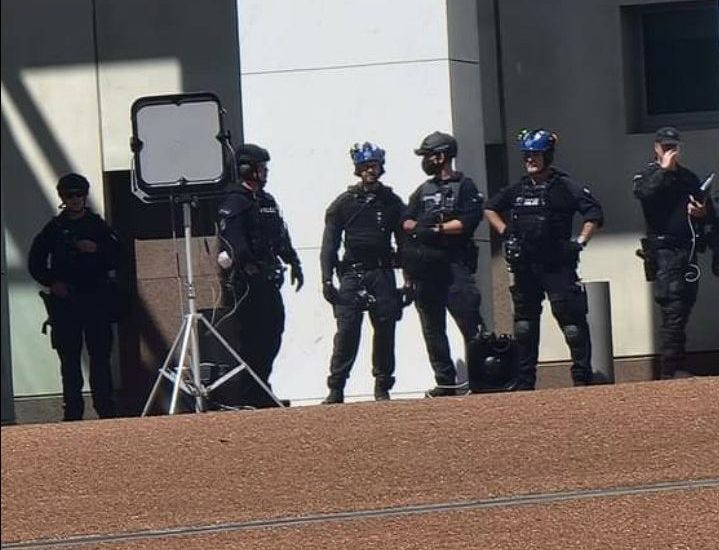Does LRAD prove conspiracies are real?
Can tinfoil-hat wearing protesters point to police admissions to insist they aren't really conspiracy theorists?
Police documents released on Wednesday confirmed that police used a Long Range Acoustic Device (LRAD) as part of the operation to disperse occupying protesters at parliament in March. But some also say that the admission proves that they aren’t conspiracy theorists after all!
Just days before the three-week long occupation of parliament’s grounds was broken up by a day-long violent operation by police, I wrote an article for The Spinoff about tinfoil hats and conspiracy claims that had been circulating among protesters on parliament’s thoroughly trampled lawn.
A viral photograph of tinfoil-hatted protesters standing in the shadow of the Beehive had drawn attention and derision online. Maybe it was an act of satirical performance art, or maybe it was a genuine attempt to protect their brains from attack by secret government weapons — it was never really clear.
Among the claims being made in the camp at the time was the suggestion that various symptoms of illness (some being suspiciously similar to those of Covid) could be attributed to a powerful sonic or energy weapon. And the LRAD was the prime suspect.
The general suspicion was that police (or, more nebulously, “the government”) were attacking protesters with some secretive weapon in order to drive them away. It was an idea — a social (media) contagion, really — that had travelled to the site from the similar protest taking place in Canberra.
“I awoke onsite at 2.30 a.m yesterday to a harmonic resonance in my head and immediately knew it was a LRAD,” wrote one ‘Camp Freedom’ resident on Telegram in late February. “I exited in 5 mins. Better than being cooked from the inside,” they concluded.
In the Australian Capital protesters had recently begun complaining of burns (described as being like a sunburn. In February. While camping) and reporting other symptoms. They attributed these effects to the use of LRAD devices by police. But the difference in Canberra was that police were actually using the LRAD.

An LRAD isn’t a subtle device. It is, essentially, a very powerful loudspeaker. But, unlike your UE Boom, it’s directional — intended to deliver a targeted beam of sound to groups of people, rather than sweet tunes to your mates at the BBQ.
And the sound it delivers is usually a verbal announcement, or a very distinctive siren-like noise intended to cause discomfort.
You know an LRAD is being used because you can see it (it requires a clear line of sight to work effectively) and you can definitely hear it. Watch videos from the police operation on March 2nd and you will probably hear the piercing siren noise.
But I wrote on February 28 saying there was “no sign of LRADs around parliament” yet now it’s admitted by police that they did use LRADs, so was I lying? Or was it all too secretive? Does the admission of LRAD use, speculated upon widely by protesters and their supporters, mean that the other claims they speculated about (the sickness and so on) were right too?
Simply put: no.
No to all that.
I wasn’t claiming that LRADs were a conspiracy theory, or even that their use (as intended) by police was some impossibility. Although at that time claims of their use by protesters in Wellington was entirely without evidence. And the physiological effects they claimed were being caused by them were certainly a conspiracy theory.
According to police, March 2nd — the day of the big police operation and, later, the fires — was the first occasion when the devices were used. There were photos of them in use. Their presence was very evident to those that were near the protests or watching the many live streams.
The ways in which the LRADs were used were entirely consistent with what you’d expect. They were loud and irritating, but they were completely audible. They weren’t delivering skin burns from a distance, inducing nausea or causing flu-like symptoms.
There are plenty of good reasons to be wary of the deployment by police of the LRAD for crowd control (they’ve now admitted they own at least 17 units, and have been acquiring them since 2016). But their use as some type of hypersonic directed energy weapon intended to cause physical injury and illness is not one.
However their potential to cause plain-old auditory harm should not be overlooked. Like other policing firsts from that day — widespread pepper spray deployment and the use of “less lethal” crowd control ammunition — we should not accept these tactics as a new normal for the policing of protests.







Fun article, and learnt a bit even with Betteridge's law of headlines